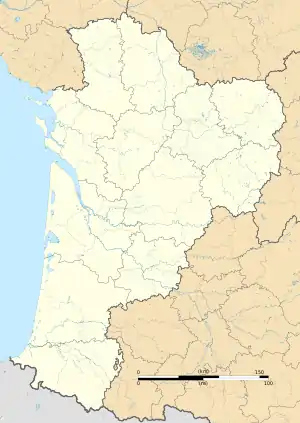Casseneuil
Casseneuil is a commune in the Lot-et-Garonne department in south-western France.
Casseneuil | |
|---|---|
 The church in Casseneuil | |
.svg.png.webp) Coat of arms | |
Location of Casseneuil 
| |
 Casseneuil  Casseneuil | |
| Coordinates: 44°26′37″N 0°37′20″E | |
| Country | France |
| Region | Nouvelle-Aquitaine |
| Department | Lot-et-Garonne |
| Arrondissement | Villeneuve-sur-Lot |
| Canton | Le Livradais |
| Intercommunality | CA du Grand Villeneuvois |
| Government | |
| • Mayor (2001–2008) | Daniel Desplat |
| Area 1 | 18.09 km2 (6.98 sq mi) |
| Population (2017-01-01)[1] | 2,386 |
| • Density | 130/km2 (340/sq mi) |
| Time zone | UTC+01:00 (CET) |
| • Summer (DST) | UTC+02:00 (CEST) |
| INSEE/Postal code | 47049 /47440 |
| Elevation | 38–204 m (125–669 ft) (avg. 52 m or 171 ft) |
| 1 French Land Register data, which excludes lakes, ponds, glaciers > 1 km2 (0.386 sq mi or 247 acres) and river estuaries. | |
Sieges of 1209 and 1214 during the Albigensian Crusade
In July 1214 Robert de Courçon, the papal legate, awarded the territories of Rodez, Albigeois, Quercy and Agenais in perpetuity to Simon IV de Montfort, who promptly set out with an army from Carcassonne to seize his new fief. Capturing the towns and destroying the castles of the existing lords, he burned the few heretics he found. All who opposed this assault, regardless of their religious beliefs, were his enemies. Many fled to the safety of Casseneuil, which had withstood the siege of 1209. However, in late August Casseneuil itself fell and he awarded Dominic de Guzmán and his preachers at Fanjeaux with the rents due from the town, though it is doubtful if they were able to collect them. His army then moved north to attack Périgord, even though it was not part of his papal grant.[2][3]
References
- "Populations légales 2017". INSEE. Retrieved 6 January 2020.
- Taylor, Claire (2011), Heresy, Crusade and Inquisition in Medieval Quercy, Boydell & Brewer Ltd, p. 98, ISBN 9781903153383, retrieved 24 December 2017
- Hinnebusch, William A. (1960), "Poverty in the Order of Preachers", The Catholic Historical Review, 45, Catholic University of America Press, p. 439, JSTOR 25016596